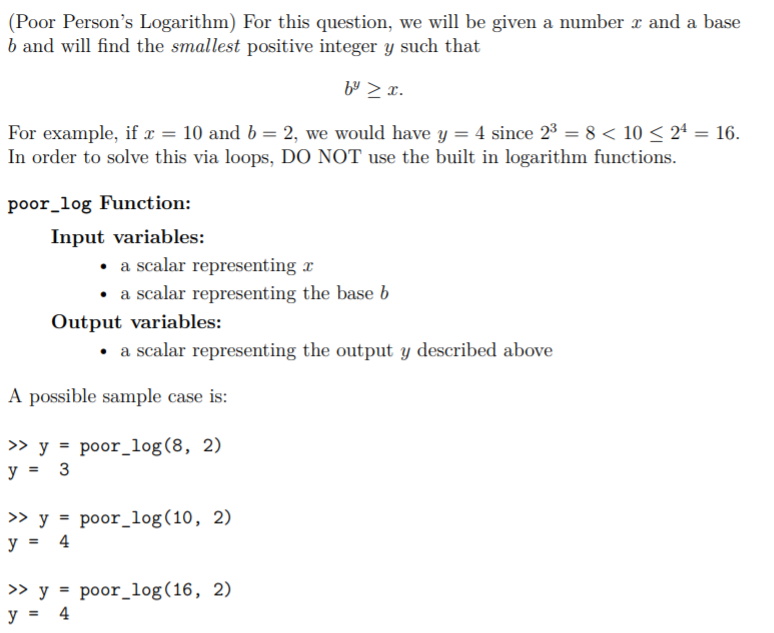(Poor Person's Logarithm) For this question, we will be given a number x and a base b and will find the smallest positive integer y such that by > x. For example, if x = 10 and b = 2, we would have y = 4 since 2³ = 8 < 10 < 2ª = 16. In order to solve this via loops, DO NOT use the built in logarithm functions. poor_log Function: Input variables: • a scalar representing x • a scalar representing the base b Output variables: • a scalar representing the output y described above A possible sample case is: > y = poor_log(8, 2) y = 3 >> y = poor_log(10, 2) y = 4 >> y = poor_log(16, 2) y = 4
(Poor Person's Logarithm) For this question, we will be given a number x and a base b and will find the smallest positive integer y such that by > x. For example, if x = 10 and b = 2, we would have y = 4 since 2³ = 8 < 10 < 2ª = 16. In order to solve this via loops, DO NOT use the built in logarithm functions. poor_log Function: Input variables: • a scalar representing x • a scalar representing the base b Output variables: • a scalar representing the output y described above A possible sample case is: > y = poor_log(8, 2) y = 3 >> y = poor_log(10, 2) y = 4 >> y = poor_log(16, 2) y = 4
C++ Programming: From Problem Analysis to Program Design
8th Edition
ISBN:9781337102087
Author:D. S. Malik
Publisher:D. S. Malik
Chapter13: Overloading And Templates
Section: Chapter Questions
Problem 17SA:
Find the error(s) in the following code: (6)
Related questions
Question
make c+++ code

Transcribed Image Text:(Poor Person's Logarithm) For this question, we will be given a number x and a base
b and will find the smallest positive integer y such that
by > x.
For example, if x = 10 and b = 2, we would have y = 4 since 23 = 8 < 10 < 2ª = 16.
In order to solve this via loops, DO NOT use the built in logarithm functions.
poor_log Function:
Input variables:
• a scalar representing x
• a scalar representing the base b
Output variables:
a scalar representing the output y described above
A possible sample case is:
>> y = poor_log(8, 2)
y = 3
>> y = poor_log(10, 2)
y = 4
> y = poor_log(16, 2)
y = 4
Expert Solution
This question has been solved!
Explore an expertly crafted, step-by-step solution for a thorough understanding of key concepts.
Step by step
Solved in 3 steps with 1 images

Knowledge Booster
Learn more about
Need a deep-dive on the concept behind this application? Look no further. Learn more about this topic, computer-science and related others by exploring similar questions and additional content below.Recommended textbooks for you

C++ Programming: From Problem Analysis to Program…
Computer Science
ISBN:
9781337102087
Author:
D. S. Malik
Publisher:
Cengage Learning

C++ Programming: From Problem Analysis to Program…
Computer Science
ISBN:
9781337102087
Author:
D. S. Malik
Publisher:
Cengage Learning